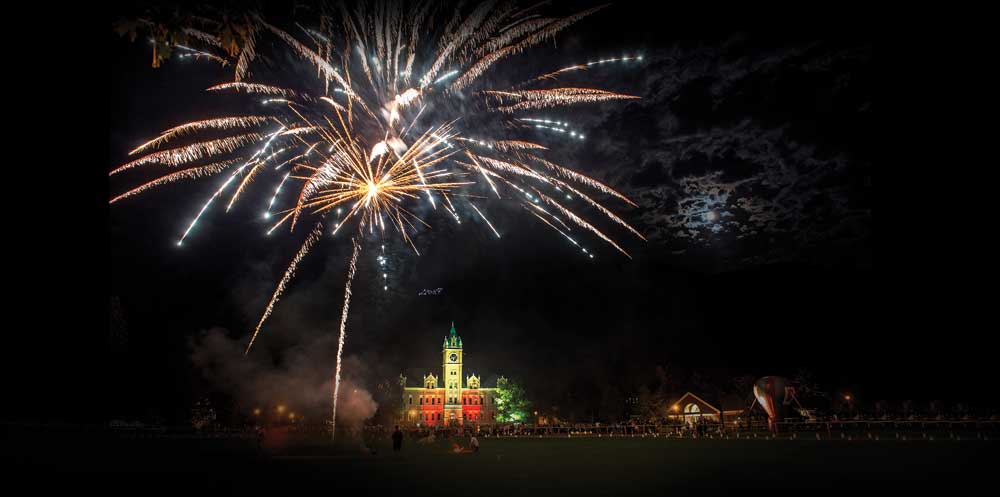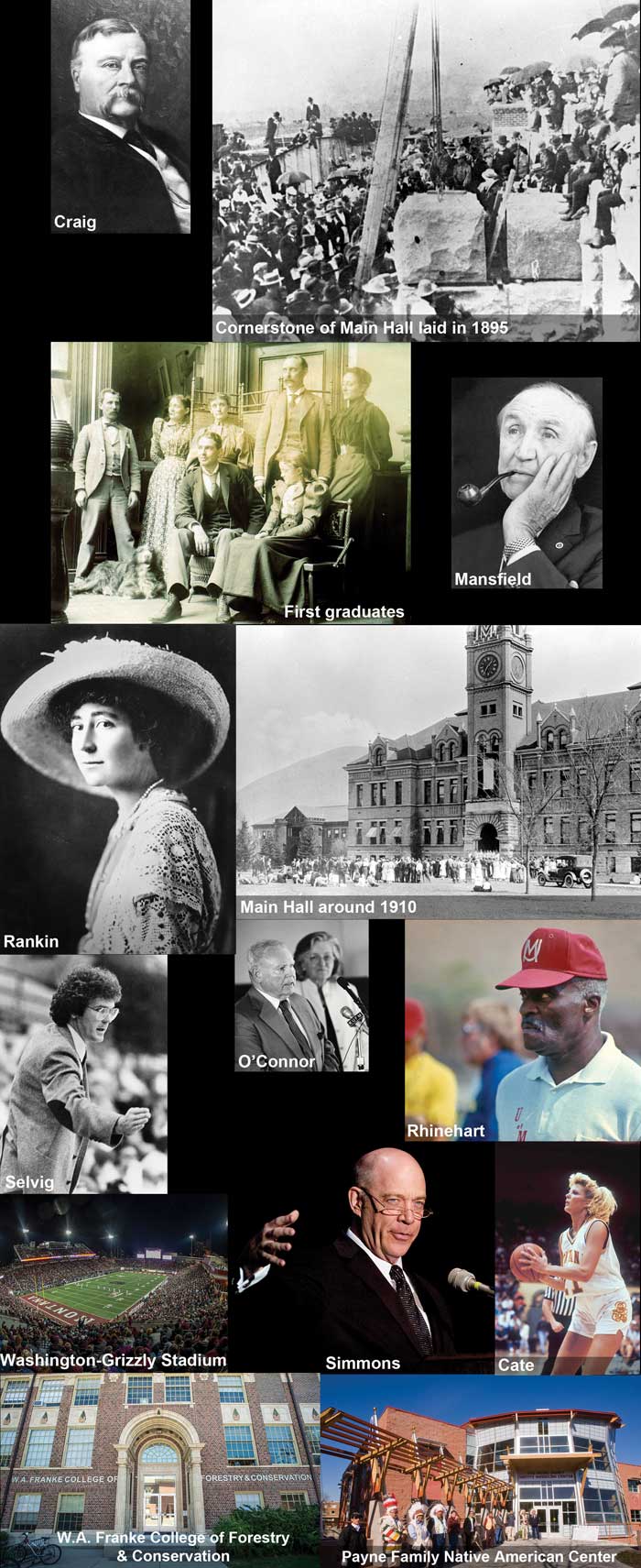- Editorial Offices
- 103 Brantly Hall
- Missoula, MT 59812
- (406) 243-2522
- themontanan@umontana.edu
125 Years and Counting
UM celebrates milestones of academics, achievement and growth
As the University of Montana approached its 125th birthday, Harry Fritz realized he had been around for 50 of them. This meant, among other things, he’d seen half the school’s presidents take office.
He was especially close with the late George Dennison ’60, M.A.’63, who was UM’s longest-serving president from 1990 to 2010. Dennison’s tenure was a special time at the University, and he in turn knew the U was a special place.
The idea was to put that down on paper.
“For 20 years he said, ‘I’m going to write this history, and you’re going to write the last chapter,’” says Fritz, Dennison’s friend of 60 years. “His project was to write a history of the University, and he jumped right into it.”
In September 2016, Dennison sent an email to remind Fritz of the agreement. Fritz was in Colorado. The final note read, in part, “I’m going to beat this disease, and we’re going to get together in January.”
But when Fritz returned on Jan. 2, 2017, Dennison was in the hospital. He died the next day of complications from non-Hodgkin lymphoma. It was too soon an end for one of the chief lovers and keepers of UM history – and one of its chief historical figures. Yet UM’s story continues.
Fritz has seen and experienced more UM changes than most. Asked about bellwether moments for the University, he points to an event that far preceded him: the creation of the School of Forestry in 1913.
“I think if you look at programs, the business school is always the highest enrollment, as it is at most schools,” Fritz says. “But the forestry school has always had a national reputation.”
It should be noted that his father graduated from the school in 1929. Today’s forestry college remains in one of the oldest buildings on campus, as it was completed in 1922.
But the Environmental Studies program is decidedly modern.
“The best thing about this school is its location,” says Fritz, a professor emeritus (“retired professor emeritus,” he corrects) in history. “In western Montana, with wilderness areas right next to it.”
When Fritz returned to campus in 1959 – after four years studying chemistry at Dartmouth – football was played in the first Dornblaser Stadium, which sat on the east side of Main Hall. The University Center and Mansfield Library own that space now.
In 1966, Dornblaser moved to a “temporary” setup at the corner of Higgins and South Avenue. Finally in 1986, the football team played its first game in the on-campus Washington-Grizzly Stadium. Football success then dovetailed with surging UM enrollment, which steadily grew from 9,000 in 1986 to a high of 15,600 in 2010.
“Fantastic,” Fritz says. “And it coincided with the hiring of Don Read as football coach. All of a sudden a school that up through 1985 had had seven winning seasons in its entire history, now has had one losing season since. Don Read was amazing.”
There is a twinkle in his eye. The campus is snowy, and outside the office a backhoe is chewing up frozen earth. Changes continue to take shape. Dennison’s book, meanwhile, percolates.
Fritz has heard it covers up to the 1930s or ’40s – or maybe the ’60s? It is 500 pages of text, but his fellow Montanan – Dennison was from the Flathead Valley, and Fritz is from Missoula – still had much to do.
“It’s all sitting over there in the archives, waiting for somebody to come pick it up,” he says. “Which I’m not really planning to do at present.”
It’s probably fitting. UM is 125 – a little long in the tooth, perhaps – but plans are underway to ensure the next 125 years of its history are equally stellar in terms of education and achievement.
A Timeline of Griz Growth
As beginnings go, 50 students and six instructors wasn’t necessarily an auspicious start for UM. But 125 years of steady growth, some setbacks and frequent greatness followed. Here are some (and certainly not all) high points in UM’s history.
 1893
1893
The Montana Legislature appropriates $15,000 “for the purpose of establishing said State University by commencing the construction of suitable buildings,” setting the stage for Missoula’s university to open its doors in 1895. It joins the State College of Agriculture and Mechanic Arts that opens in Bozeman in 1893, the State Normal School in Dillon (1897) and the School of Mines in Butte (1900).
1895
When it opens, the University of Montana and first President Oscar J. Craig have 50 students, five of whom are prepared for college work, according to historian H. G. Merriam.
For a few years it is more a preparatory school for students ages 13 and up. But by the end of that first school year, there are 130 students. At the time there are six faculty members, including William Aber, professor of Greek and Latin. By 1908, when Craig leaves for health reasons, there are 27 faculty and the school had its first Rhodes Scholar, George Barnes (in 1904). Main Hall and the Science Building open their doors in 1906.
1897
Playing on the road in Bozeman, the Grizzly football team bests the Bobcats 18-6 in the first-ever game between the schools, thus starting one of the oldest rivalries in the United States.
UM owns a 72-39-5 series lead, though a lot of that bulge came during a 16-game Griz winning streak from 1986 through 2002. Montana has gone 8-7 against the Cats in the “Brawl of the Wild” since ’02.
1911
The School of Law opens after three years of pointed support by University President Clyde A. Duniway – who is then dismissed by Montana’s Board of Education in 1912. Duniway went on to be president of the University of Wyoming. The nationally renowned Alexander Blewett III School of Law gets a new building in 1961.
1913-14
The universities in Bozeman and Missoula make a trade: The pharmacy school moves to the campus at the base of Mount Sentinel, and the state’s engineering school moves to Bozeman. In 1913, Montana launches its journalism school, which is housed in tents on the Oval. In 1914, the School of Music opens inside a Main Hall room that is too small to house a piano. The J-school would move into a permanent building in 1939 (and into the $14 million Don Anderson Hall in 2007). The School of Music had its permanent home in full use by 1954. Around 1913, the University starts being called the State University of Montana. In 1935, it is renamed Montana State University (gasp!), and this lasts until 1965, when the Legislature restores UM's original moniker.
1918
Montana opens its School of Business with around 25 students. The school is shuttled from building to building on campus before moving into the new education building in 1950. In 1996, the school moved into the William and Rosemary Gallagher Business Building, taking over what had been the Clover Bowl intramural fields.
1929
A nontraditional student named Mike Mansfield ’33 hits campus with the financial help of his wife, Maureen. The rest is pretty well-known history. Mansfield earns a master’s in 1934, teaches at Montana until 1942 and then wins the U.S. House seat that had been vacated after one term by Jeannette Rankin. He serves five terms and then wins a seat in the U.S. Senate in 1952. He becomes the longest-tenured Senate majority leader, serving 1961-77. Upon his retirement from public life as the U.S. Ambassador to Japan in 1989, he receives the Presidential Medal of Freedom. The former Butte mucker, who’d left school at age 14 to join the U.S. Navy in World War I, had made good. He would wish folks a fond farewell by saying, “Tap ’er light.” Those are just a few reasons UM named its library for Maureen and Mike Mansfield upon its completion in 1978.
1931
Milwaukee, Wisconsin, product Naseby Rhinehart comes to Montana to play basketball and football and run track for the Grizzlies. In 1935, Rhinehart, who had planned to return to Wisconsin and be a police officer, is offered the position of athletic trainer for the Griz. He stays 47 years, retiring in 1982. He was one of the first people to put together an athletic training curriculum in the U.S., doing so for UM in 1971. Montana named its athletic training room in his honor in 1993. He passed away in Missoula in 1991. Rhinehart wasn’t the last black athlete to attend UM, and he also wasn’t the first: He was pointed toward Missoula by James Dorsey ’22, a former Griz football player who in 1927 became the first African-American to graduate from Montana’s law school.
1940
Jeannette Rankin 1902 is elected to the U.S. House of Representatives for a second time. As with her first election in 1916, the United States is on the cusp of world war. She becomes the only member of Congress to vote against U.S. involvement in both wars. In 1916, she was the first woman sent to Congress. She remains the only woman from Montana so elected.
1946
Carroll O’Connor comes to UM to study English. The Manhattan, New York, native finds his love for acting with Montana’s drama department and meets his wife, Nancy Fields, during a production. O’Connor returns to campus in 1956 to pursue his master’s and, eventually, became one of the greatest television stars in history. His iconic role is playing Archie Bunker on “All in the Family” in the ’70s.
1965
KUFM, a radio station and flagship for Montana Public Radio, goes on the air. It’s hard to measure the many effects this station has had on students, parents of students, UM employees and the people of Montana. Station contributor Kim Williams did guest commentaries on “All Things Considered” and made two appearances on "Late Night with David Letterman." The walking and biking trail adjacent to campus bears her name.
1971
A 6-foot-2 basketball recruit named Robin Selvig ’74 from Outlook hits campus. He has a sterling career for the Grizzlies but really makes his mark by taking over the fledgling Lady Griz basketball team – in 1978 and at the ripe old age of 25. Twenty-one league championships follow before Selvig retires with 865 coaching victories.
1973
Jonathan Kimble Simmons, whose father has just become director of the School of Music, begins pursuing a music degree with an idea of composing. But upon graduating in 1978, he joins the Seattle Repertory Theater, then moves to Broadway and becomes a full-time actor. A part with HBO’s “Oz” and stints with “Law & Order” and “The Closer” gave way to his portrayal of crusty newspaper editor Jonah J. Jameson in the Spiderman movies. The work kept coming, and in 2015, Simmons took home a Best Supporting Actor Oscar for “Whiplash.”
1975
The Montana Grizzlies face the vaunted UCLA Bruins in the NCAA men’s basketball tournament and lose 67-64. The game is memorable because undersized forward Eric Hays ’75 scored 32 points – before getting knocked out by a referee signaling change of possession. The Griz gave the Bruins their toughest game on their way to a 10th NCAA title in 12 seasons, after which UCLA coach John Wooden retired. That game put Montana’s basketball program – then under the tutelage of Jud Heathcote – back on the map. The Grizzlies have stayed a Big Sky Conference power through most of that century and this one.
1986
Washington-Grizzly Stadium opens, with Montana’s 38-31 Big Sky Conference football victory over Idaho State. The Grizzlies’ new stadium, which seated 15,000 if you squeezed a couple thousand people onto the grass berms above each end zone, became the jewel of the Big Sky by 1996. Expansions came in 1995, 2003 and 2008. Now it holds more than its listed capacity of 25,217 – we know because the Griz drew 26,472 to their season-opening win over North Dakota State in 2015. The Grizzlies are 197-30 all-time inside the stadium’s cozy confines.
1992
Shannon Cate finishes her Lady Griz career with 2,172 career points, making her the all-time leading scorer among both men and women in the Big Sky Conference. As a player, Cate led Montana to four NCAA tournaments, three Big Sky Conference regular-season titles and a record of 103-18. Shannon Schweyen is now the Lady Griz head coach.
1995
With 44 seconds left, Andy Larson hits a 25-yard field goal to give the Montana Grizzlies a 22-20 win over Marshall for the Football Championship Subdivision (then Division I-AA) title. It caps a clutch, 72-yard drive led by Walter Payton Award-winner Dave Dickenson ’96, who broke scads of passing records at UM. Dickenson, recently selected for the College Football Hall of Fame, completes a fourth-down pass to Mike Earhardt along the way. “I’m happy, but in the same sense, I planned it,” says Dickenson, who went on to star in the Canadian Football League and now coaches the Calgary Stampeders. “I wasn’t coming here to lose.” The Griz would win another FCS title in 2001 behind John Edwards and Yohance Humphery. The Griz also appeared in five other title games.
2008
In one of the final major acts of a tenure that was, well, groundbreaking, President George Dennison oversees a groundbreaking for UM’s Payne Family Native American Center. Of serving Native American students, Dennison, who would retire in 2010, said, “We can and must do better. This center reflects our commitment.”
2009
The Phyllis J. Washington Education Center is completed, as a 27,000-square foot addition to the Education Building. The UM School of Law also was refurbished and increased in size to nearly 46,000 square feet. In recent years other projects have enhanced buildings such as the Native center and the Liberal Arts Building.
2016
UM receives the largest single gift in its history – $24 million – from Bill and Carolyn Franke and their family. The gift supports the renamed W.A. Franke College of Forestry and Conservation and the Franke Global Leadership Initiative.
2017
A grand opening is held for UM’s new Missoula College Building. The 115,000-square-foot, four-story structure is part of the new “river campus” located just across the Clark Fork River from the University’s central campus.




